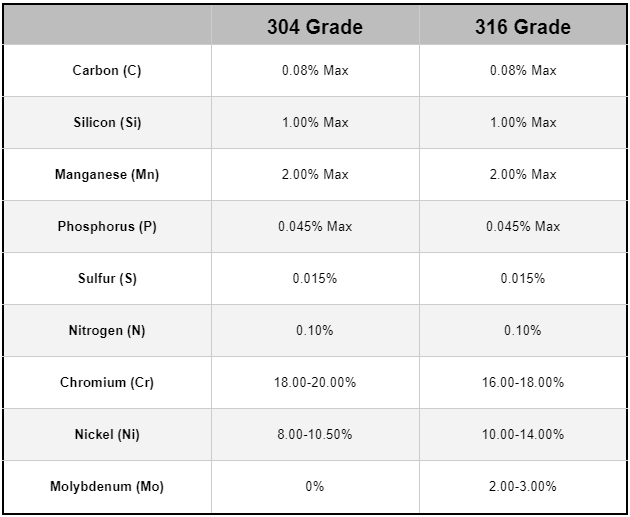In the world of materials science, stainless steel is a true engineering marvel, and the 300 series austenitic grades stand out as some of the most versatile and widely used. These alloys are known for their excellent balance of strength, ductility, and corrosion resistance, making them ideal for a wide range of applications. Among these, grades like 304 and 316 are particularly popular due to their high-quality performance and adaptability in both industrial and everyday settings. At the core of all stainless steels lies chromium, which plays a crucial role in providing the material with its defining properties. With a minimum content of 10% by weight, chromium reacts with oxygen in the environment to form a thin, protective oxide layer on the surface. This passive film acts as a barrier, preventing further oxidation and corrosion, which is why stainless steel remains "stainless" even under harsh conditions. Among the many grades in the 300 series, 304 stainless steel is the most commonly used. It contains approximately 18% chromium and 8% nickel, often referred to as 18/8 stainless steel. This composition gives it excellent corrosion resistance, good mechanical properties, and ease of fabrication. Its versatility makes it a top choice for everything from kitchen utensils and food processing equipment to architectural components and industrial machinery. When it comes to resisting more aggressive environments, 316 stainless steel is the go-to option. It includes molybdenum in addition to chromium and nickel, which significantly enhances its resistance to pitting and crevice corrosion—especially in chloride-rich or marine environments. This makes it highly suitable for use in chemical processing, marine engineering, and medical devices where durability and reliability are essential. While both 304 and 316 offer excellent performance, they excel in different scenarios. 304 is ideal for general-purpose use where standard corrosion resistance is sufficient, while 316 is preferred in more demanding conditions, such as coastal areas or chemical exposure. The addition of molybdenum in 316 gives it an edge in environments where chlorides may cause damage. One of the key advantages of the 300 series is their excellent weldability and formability. Both 304 and 316 can be easily shaped into complex forms without losing their structural integrity. Although they cannot be hardened through heat treatment, they can achieve high strength through cold working. For applications that require both welding and forging, low-carbon versions like 304L and 316L are often recommended due to their improved weldability and reduced risk of intergranular corrosion. The applications of 304 and 316 stainless steels span multiple industries. Grade 304 is widely used in kitchens, restaurants, and commercial buildings due to its durability and aesthetic appeal. It's also common in plumbing systems, automotive parts, and construction. On the other hand, 316 is favored in more extreme environments, such as offshore platforms, desalination plants, and pharmaceutical equipment, where exposure to saltwater or chemicals is a concern. Both grades have their own unique strengths, and choosing between them depends on the specific needs of the application. While 304 offers great value and performance in most cases, 316 is the better choice when long-term durability in harsh environments is required. Beyond the standard 304 and 316 grades, there are super austenitic stainless steels designed for even more extreme conditions. These grades contain higher levels of nickel and sometimes additional elements like nitrogen or copper, which enhance their resistance to corrosion, oxidation, and stress cracking. They are often used in high-temperature environments, chemical processing, and deep-sea applications where conventional stainless steels might fail. The primary reason for their corrosion resistance is the presence of chromium, which forms a protective oxide layer. In the case of 316, the addition of molybdenum further improves its ability to resist pitting and crevice corrosion, especially in chloride-rich environments. Molybdenum increases the alloy’s resistance to localized corrosion, such as pitting and crevice corrosion, particularly in seawater or acidic environments. This makes 316 a preferred choice for marine and chemical applications. Super austenitic grades are advanced versions of the 300 series, offering even greater corrosion and oxidation resistance. They are typically used in extreme environments, such as high-temperature or highly corrosive conditions, where standard 304 and 316 may not perform adequately. Shop Stainless Steel Instrumentation Fittings Shop Stainless Steel Cast 150# Fittings Shop Stainless Steel Nipples Shop Stainless Steel Forged 3000# Fittings Shop Stainless Steel Flanges Shop Stainless Steel Weld Fittings Shop Stainless Steel Tubing Industrial Agitator,Industrial Stirrer,Industrial Agitator Mixer,Industrial Mixers And Agitators wuxi top mixer equipment co.,ltd , https://www.wxtpmixer.comIntroduction to 300 Series Austenitic Stainless Steel

The Foundation of Stainless Steel: Chromium
304 Stainless Steel: The Versatile Workhorse
316 Stainless Steel: The Corrosion-Resistant Champion
A Comparative Look: 304 vs 316 Stainless Steel
Welding and Forming: The Common Strengths
Typical Uses Across Diverse Industries
Super Austenitic Grades: Extending Performance
Compositions of Austenitic Stainless Steel
Frequently Asked Questions
1. What makes 304 and 316 stainless steel resistant to corrosion?
2. How does the addition of molybdenum enhance the properties of 316 stainless steel?
3. What are super austenitic grades, and how do they differ from 304 and 316?